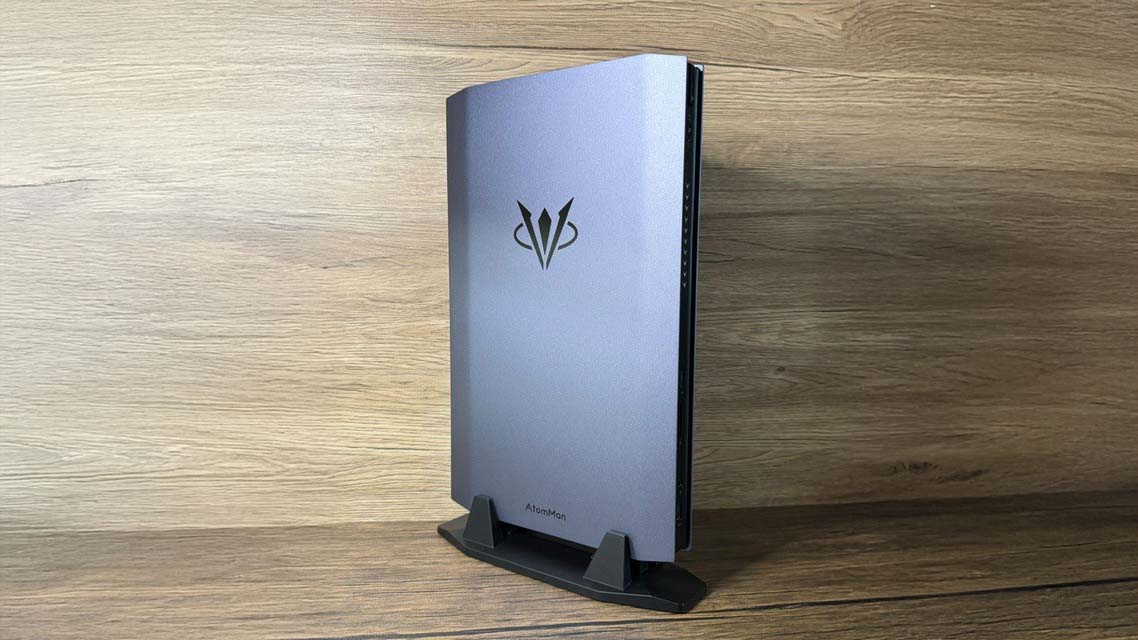Our Verdict
A highly performant machine, but the outrageous CPU and slim vertical form-factor introduce some difficult compromises.
For
- Top-tier mini-PC performance
- Tiny desktop footprint
- Clean, industrial design
Against
- Noisy and throttly
- Awkward form-factor
- Lacking in IO
PC Gamer's got your back
Spend any time with Miniforum's AtomMan G7 PT and it's clear you're dealing with a tidy piece of engineering. The looks I can leave behind, but the choice of performant components, well-managed by a quiet and competent cooling solution, makes for a neat package. It's a beast at 1080p, competent at 1440p with reduced settings and, in a world of off-the-peg machines, represents the kind of technical innovation we love to see.
This next offering in Minisforum's AtomMan line may be viewed as the G7 PT's bigger brother. Marrying Nvidia's laptop RTX 4070 with Intel's Core i9 14900HX, The G7 Ti is a blade-thin desktop machine which is more squarely aimed at 1440p gaming. With its clean-and-sharp aluminium panelling and understated RGB flighting, it cuts a rather more serious and mature figure than the G7 PT.
Pop the side-panel off and the reason for its slim-and-tall form factor is plain to see. It's literally built around a laptop motherboard, with four wee daughter-boards cabling off to perform external IO duties. This isn't the standard modus operandi for Minisforum, which usually opts for custom APU boards and cooling in its mini-PCs.
A copper Yakisoba of heat-pipes shrouds the lower half of the mobo, which is heartening given the choice of CPU. In mobile terms, the mobile RTX 4070 is no slouch, but the Core i9 14900HX is downright monstrous; a 24-core, 5.8 GHz, desktop-level bulldozer. Together, they make for highest-performing mini-PC we've tested, outpacing both the ASUS ROG NUC and the Zotac Zbox EN—both of which pack the same GPU—across a range of synthetic and gaming benchmarks.
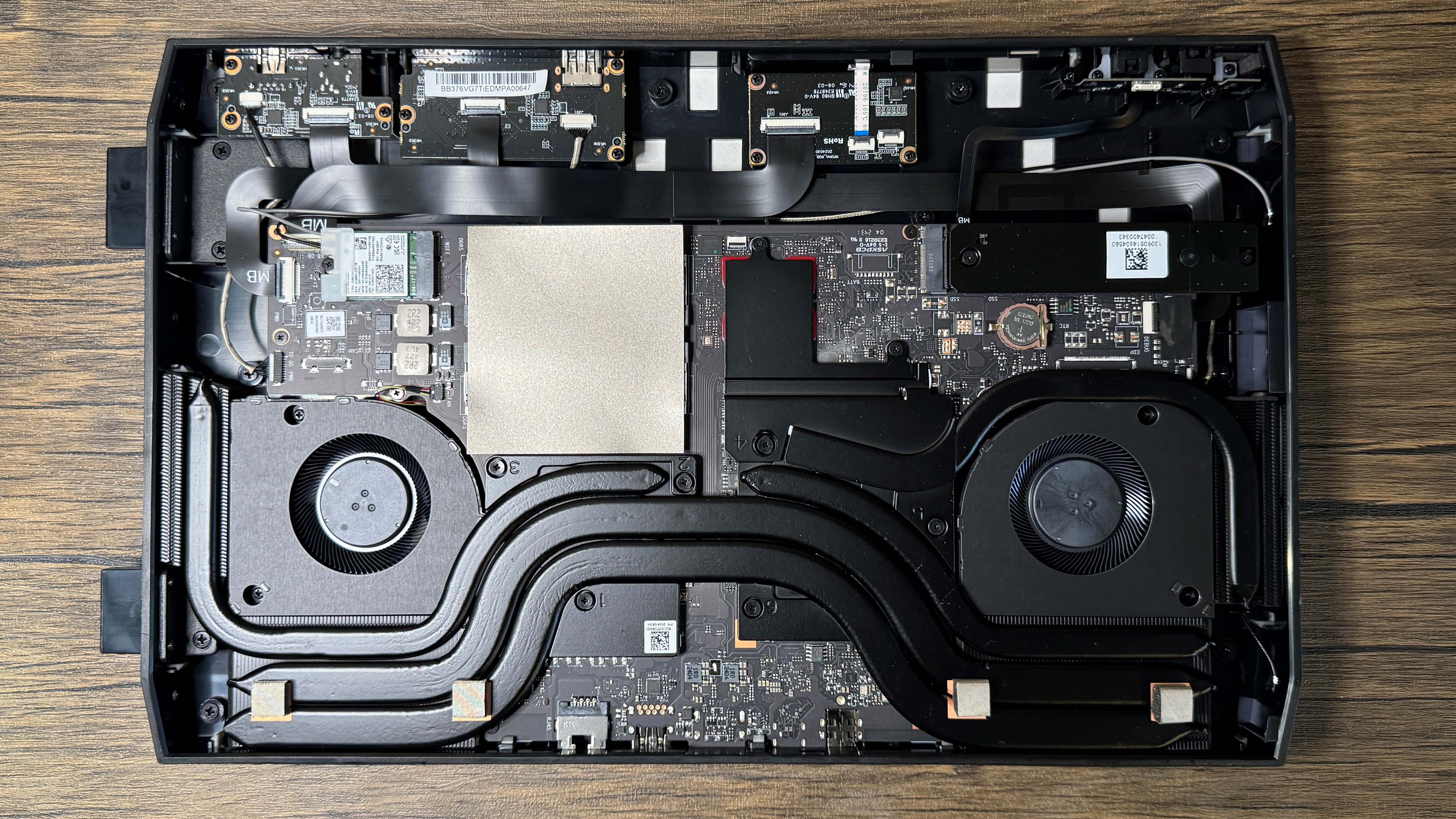
CPU: Intel Core i9 14900HX
GPU: Nvidia RTX 4070 mobile
Memory: 32 GB DDR5 5600 MHz SODIMM
Storage: 1 TB M.2 NVME SSD
Wireless: WiFi 7, Bluetooth 5.4
I/O front: 2x USB 3.2 Type-A, SD reader, Audio jack
I/O rear: 1x HDMI 2.1, 1x USBC Data/DP/PD), 1USB 3.2 Type-A, 1x 2.5G LAN
Price: $1439 | £1349 (1TB storage, 32GB RAM) | $1279 | £1249 (Barebones)
Like the G7 PT before it, the G7 Ti has two performance modes which alter the CPU's TDP from max 85W to max 115W, with different fan-RPM profiles configured for each. There's a button on the front of the chassis to toggle between the modes, or you can use the preinstalled hardware-management app, which also lets you customise the RGB lighting. Cranking the TDP up helps the machine blast through rendering workloads at a tangibly greater pace, though the performance gains you'll see in gaming are entirely title-dependent.
There's no doubt the G7 Ti makes for both a capable workstation and a solid 1440p gaming machine. Running Cyberpunk 2077 at the Ray Tracing Ultra preset, with DLSS and Frame Gen, sees a tidy 84 fps at 2560x1440 in 85 W mode, and 86 fps at 115 W. Homeworld 3, a more CPU-intensive title, sees bigger gains with a jump from 62 to 72 fps, but neither Forza (69 fps) nor Total War: Warhammer 3 (96 fps) saw any notable uplift for running the TDP up to 115 W.
And in all honesty, you won't want to. The G7 Ti's little turbo-prop blowers are silent at idle and maintain a bearable volume at 85 W under gaming loads, generating a consistent but largely unintrusive blow. Jump to 115 W though, and the noise becomes obnoxious. Neither mode produces any nasty variable coil-whine frequencies; it's very much the passage of air you're hearing, which is preferable. But with the CPU scarfing down 115 W in performance mode, the sheer volume emitted by the blowers at their max RPM is impossible to ignore, even with headphones on.
While I was benchmarking the machine, my wife (who works a couple of rooms away in our abode) poked her head round the door to say "It's so weird, I swear I can hear heavy rain but it's blue skies outside." Then her eyes alighted on the G7 Ti, puffing its cheeks and emitting a high-pressure TCHHHHHHH from its desktop perch, and the penny dropped.
CPU temps hover around the 90 °C mark, so my first assumption was "well, at least the cooling is keeping things in check," but HWinfo tells a different story. Whether at 85 W or 115 W, the CPU begins to throttle under load. Which means you're bouncing off the redline and not getting the full potential of the chip.
All of which leads one to conclude that this particular CPU in this particular form-factor just isn't the most sensible combination. The ultra-slim design doesn't allow for the volume of copper, or the larger and slower-spinning fans that the i9 14900HX so desperately needs to keep heat in check without throttling or setting off car alarms.
It's also not a sensible pairing with what is effectively a midrange laptop GPU. I suspect the G7 Ti would fare just as well at 1440p with a less power-hungry chip; an i5, Core Ultra, or modern Ryzen APU perhaps. And in fact, a variant of this machine—the AtomMan G7 Ti SE—is available at a slightly cheaper prince-point with the i7 14650HX. It's still a beast, but with lower turbo-boost clocks (5.2 GHz compared to the 14900HX's 5.8 GHz) and 8 fewer E-cores, it strikes me as being something approaching a saner match with the RTX 4070 mobile in a slim form-factor.
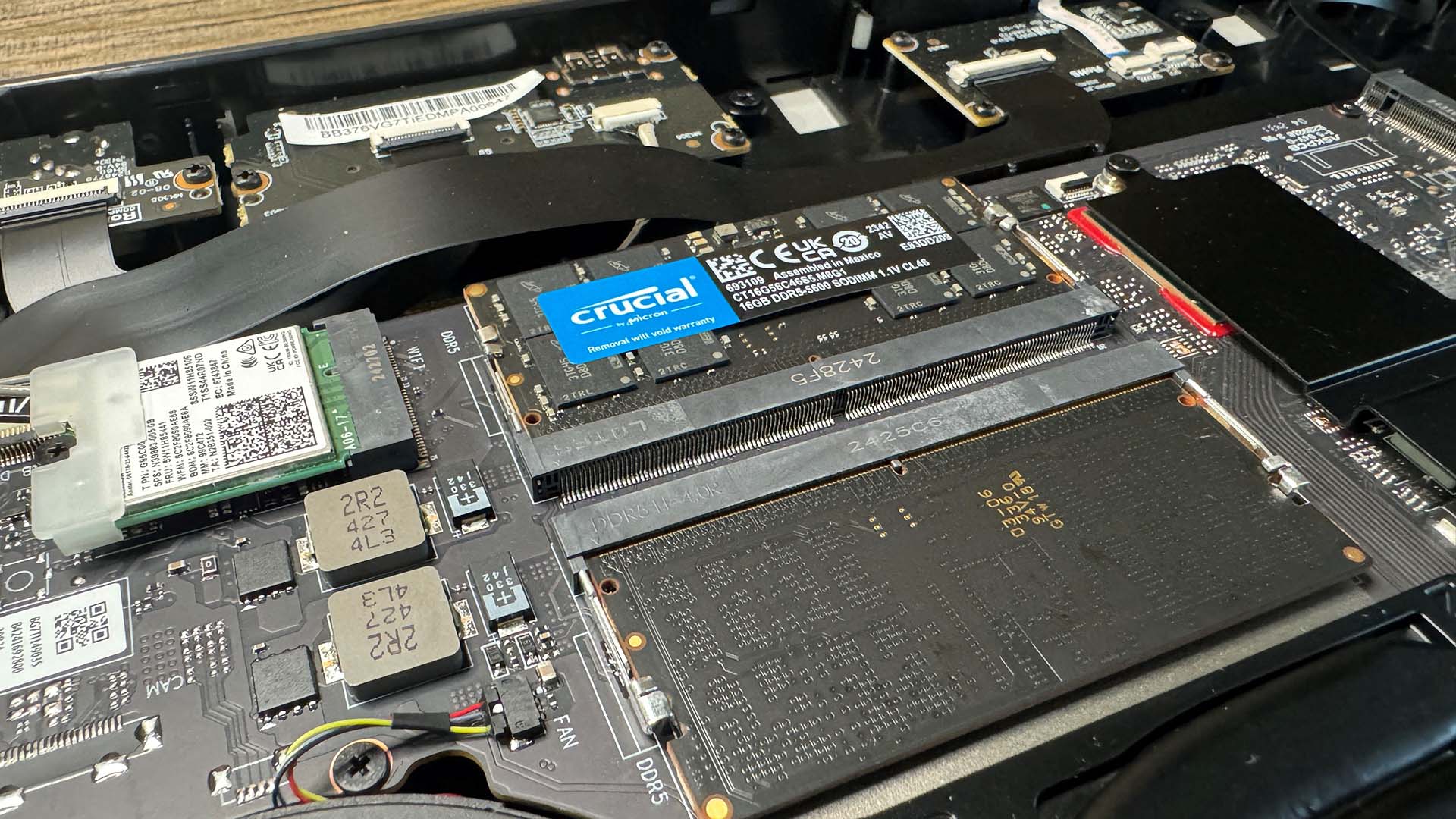
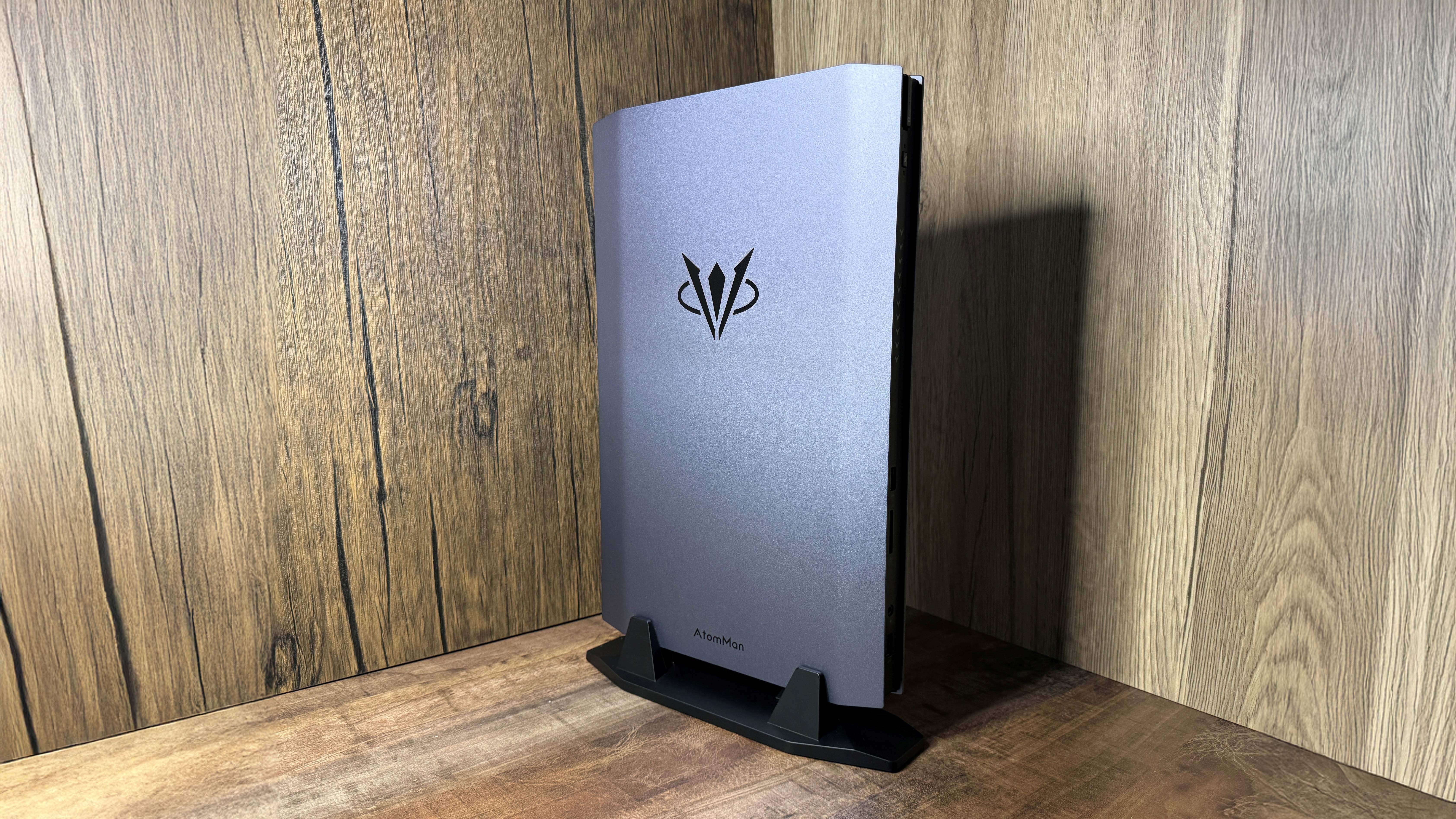

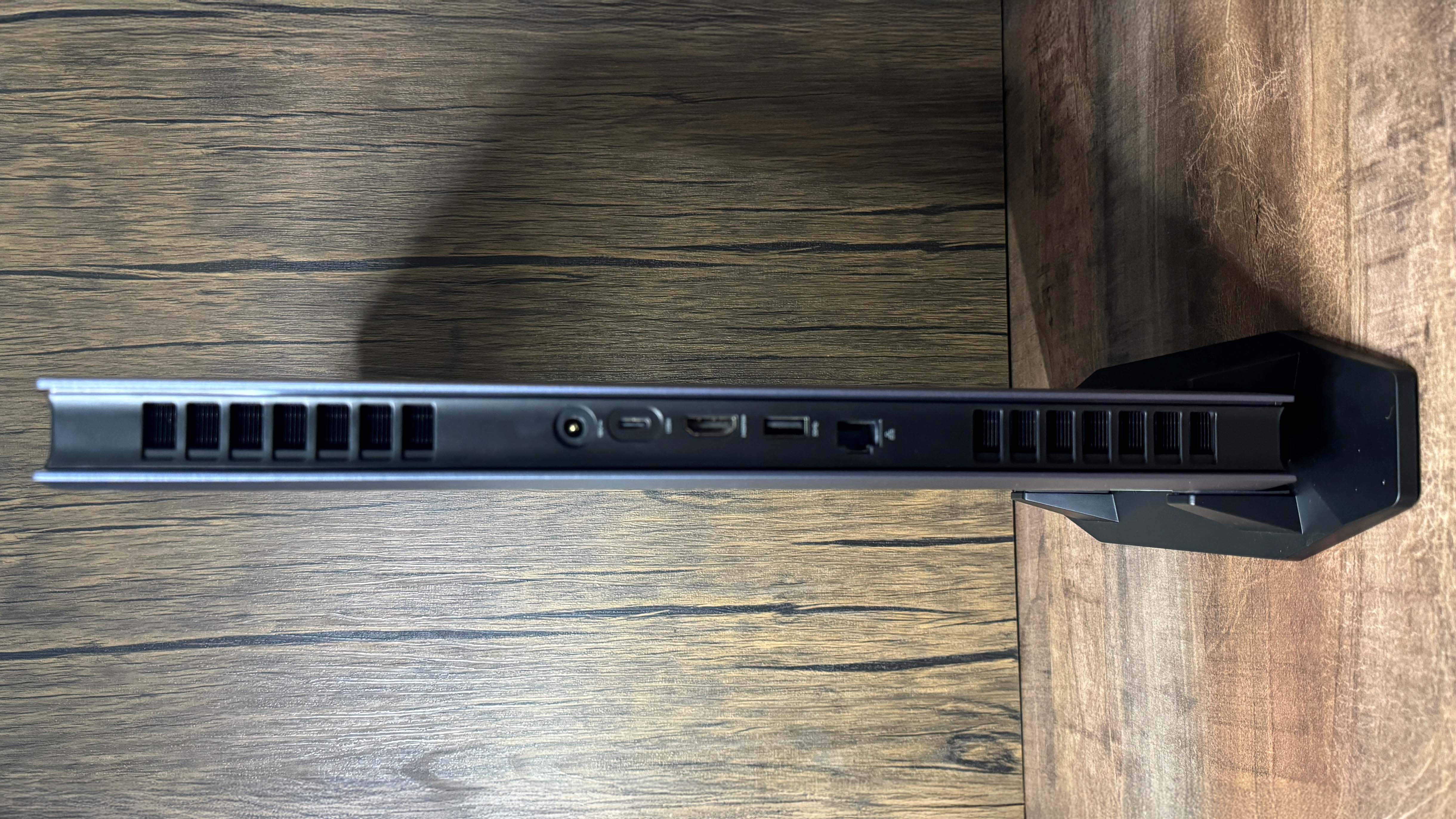
While WiFi7 and Bluetooth 5.4 are very welcome, the physical IO is not quite up to par. A single Type-C USB4 at the rear, and none up front? That's not great. Plus, the lack of a dedicated DisplayPort means that, if you want to run a DP cable to your monitor, you need to devote that single USBC socket at the rear to doing so. Which of course means no USB-C peripherals for you, plucky reader, unless you add a hub to your shopping list. The lack of any audio jack at the rear is another annoying omission, as it means trailing a 3.5mm jack round to the front if you want to plug in a set of desktop speakers.
There's also some awkwardness with the form-factor. The vertical alignment looks cool, but isn't comforting, as there's a lot of vertical weight balanced on that slim stand; it wouldn't take too much of a nudge to topple it. Plus, the cable from the external power-brick connects to the upper-portion of the rear-end, which introduces an extra leverage-point. This wouldn't be an issue if it connected nearer the base.
Laying the unit flat on your desk is out of the question, as the right-hand side-panel—what would be the ‘underside' if you were to lay it down - is all air-intake. In any case, a horizontal aspect would take up similar desktop real-estate to a tower PC; you'd be losing the one benefit of its blade-like design, which is the agreeably tiny footprint.
✅ You're a power-monger: The Core i9 14900HX is a rendering beast.
✅ 1440P is your sweetspot: Best-in-class mini-PC performance at 2560x1440.
❌ You want to hear yourself think: In performance mode, the fans work overtime.
❌You want a truly mini-PC: The sheer vertical height pushes the definition somewhat.
It all adds up to a machine that is somewhat in limbo. It's a static PC with a small desktop footprint but a large visual one, which underperforms against a desktop machine at the same price-point. Equally, there are identically-specced laptops out there that cost around the same, but offer the added benefits of a screen, keyboard, trackpad, speakers and mobility.
There's no question that It's a great performer at 1440p, even with the CPU limited to 85 W, which keeps the fans at a sedate and palatable volume. But that touches on my biggest gripe with the machine; if you want to get the best out of its Core i9 14900HX and feed it 115 W in performance mode, you're kind of punished for doing so. It quickly starts hitting the throttle and the cooling system becomes unbearably noisy.
This particular CPU in this particular form factor is overkill. And while I think Minisforum—an outfit with good form in bespoke cooling—has done its level best to tame the beast, there are way more sensible processors out there to build a slim gaming machine around, and better tier-matches for the mobile RTX 4070 GPU.
A highly performant machine, but the outrageous CPU and slim vertical form-factor introduce some difficult compromises.

Al's games-and-tech quilling began on PC Gamer Specials magazine in the year 2000, before moving on to PC Format and then out into game development. In the last 23 years he’s reviewed a bajillion games and assorted pieces of hardware, spent 13 years in game dev, built PCs, dry-stone walls, and ebikes, and logged 1000 hours in Fallout 76. His current obsessions are tiny PCs and sledgehammering every single object in Dysmantle into its constituent parts.
